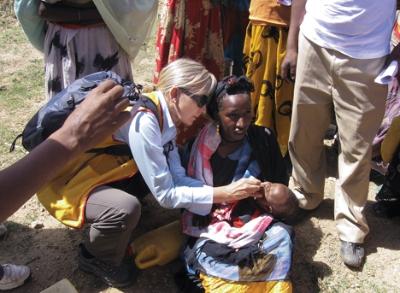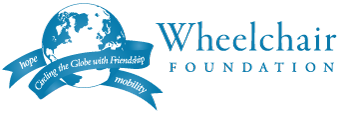
Local rotarians Christiana Flessner (above, left) administers the polio vaccine to a young Ethiopian child.
She watched a woman sacrifice her wages to carry her 14-year-old disabled son to school, and saw a crippled man wear sandals on his hands to protect them from the rough ground he was forced to crawl on.
“People have been dragging themselves in the dirt, sometimes all their life,” the South Surrey resident said.
Not only did she help those struggling with the effects of polio during her one-week stay in the African country, but Flessner also contributed to eradication efforts by administering vaccinations.
A Semiahmoo Rotary Club member, she travelled with a group of more than 40 from the Seattle Rotary district.
The team vaccinated hundreds of children up to five years old, having been shown by Ethiopian health officials how to tilt a child’s head back and put two drops of the vaccine into his or her mouth.
Armed with coolers full of vials holding the preventative, Flessner spent two days seeking out eligible children.
She went to a school where she was surrounded by hundreds of smiling, excited kids, and drove more than three hours to a small village close to the Somali border, where she walked house-to-house to offer the inoculation.
Flessner said it was rewarding to know each child she saw would never contract polio.
“When you put the drops into a child’s mouth like that, it’s like, ‘OK, you’re safe, you’re safe.’”
Around 200 Rotary members from other parts of the world were also volunteering for the campaign, which was centred around World Polio Day Oct. 24.
Flessner said the effort is held several times a year in Ethiopia with the goal of making it polio-free, a certification earned once a country goes three years without a new case.
A Rotary group from the Pacific Northwest has travelled to Ethiopia annually to provide the immunizations for the last 15 years, raising money for vaccines, transportation within the country and to advertise their visit to residents ahead of time.
Flessner, who was invited by a friend to take part, jumped at the opportunity to support polio prevention, but also to help those left crippled by the viral disease, which can cause muscle paralysis.
As executive director of Canadian Wheelchair Foundation – a charity based on the Peninsula that distributes wheelchairs to those without the means to acquire one – Flessner handed out 280 wheelchairs during the first days of her trip.
With the equipment – designed to be sturdier for Third World countries – Flessner said disabled people can work and support themselves, rather than being forced to become beggars.
“People are always surprised and dumbfounded because, to us, a wheelchair almost seems like not much, but in a developing country, it’s a big thing,” she said.
Flessner hopes to merge another wheelchair distribution effort with a polio immunization campaign next year in Pakistan, then again in Afghanistan.
It’s the look of astoundment and gratitude on recipients’ faces that makes it all worthwhile.
“It’s so rewarding, and it changes your life when you come home,” she said. “You try to change other people’s lives for all the right reasons, but you come home being changed yourself.”
SOURCE: Peace Arch News
